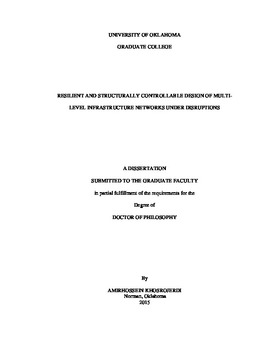| dc.description.abstract | An infrastructure network comprises of different entities that are connected by the flow of materials, products, information or electricity. Disruptions could occur at any section of the network for a wide variety of reasons. Some examples include: company mergers (e.g., Halliburton’s impending purchase of Baker Hughes), labor union strikes (e.g., labor strike on the west coast of the United States in 2002), sanctions imposed or lifted (e.g., economic sanctions against Iran being lifted by the UN in July 2015), plantations being destroyed (banana plantations were destroyed by Hurricane Mitch in 1998), air traffic being suspended due to weather or terrorism, main suppliers put out of commission by natural disasters (e.g., the 1999 earthquake in Taiwan disrupted semiconductor fabrication facilities), etc. A resilient infrastructure network is one that has the ability to recover quickly from disruptions and ensure customers are minimally affected, while the simultaneous design of operational and strategic decisions in all levels of the network structure are considered. It becomes very important to design a resilient multi-level infrastructure network in order to manage disruptions using appropriate pre-disruption and post-disruption restoration strategies. The capability of structural controllability can help in recovering a disrupted infrastructure network and increasing its resilience before, during and after the occurrence of disruptions.
In this dissertation, the problem of applying structural controllability in order to design a resilient multi-level infrastructure network under disruptions with the selection of appropriate restoration strategies and consideration of the trade-off between effectiveness and redundancy in the resilience analysis is considered. The aforementioned problem has four aspects worth of consideration: a) multi-level network structures, b) restorations strategies, c) resilience analysis, and d) structural controllability. In this regard, the primary research question is defined as: What methods are required for designing a resilient infrastructure network under disruptions through selecting appropriate restoration strategies in a manner of applying structural controllability? The primary research question is broken into four secondary questions in respect to each four aspects of the considered problem as follows.
- What is a method to design a multi-level infrastructure network (e.g., node-level and network-level structures) considering both operational and strategic decisions?
- What is a method to design a resilient infrastructure network through selecting appropriate pre-disruption (e.g., facility fortification, backup inventory) and post-disruption (e.g., reconfiguration, flexible production and inventory capacity) restoration strategies?
- What is a method to evaluate network resilience as a function of time considering effectiveness and redundancy measures (e.g., service level and transportation time as effectiveness measures and control cost as redundancy measure)?
- What is a method to determine the minimum number of driver nodes (i.e., driver nodes or controllers are required for controlling networks) to get structurally controllable infrastructure networks?
In response to the primary research question, two methods are proposed in this dissertation. The first method is the multi-level infrastructure network (MLIN) method which refers to the first aspect of the problem. The second method is the resilient and structurally controllable infrastructure network (RCIN) method which refers to the second, third and last aspects of the problem. Based on these two proposed methods, the main created new knowledge in this dissertation is in tailoring and incorporating the structural controllability theory in the resilience analysis of disrupted infrastructure networks.
The proposed MLIN and RCIN methods are verified and validated using two examples from the energy industry in the context of the validation square. An example of a network of electric charging stations for plug-in hybrid electric vehicles using renewable energy and power grid as sources of energy is used to demonstrate and validate the MLIN method. An example of a network of a multi-product European petroleum industry is used to demonstrate and validate the RCIN method. Although the proposed methods are solved for the two examples, both of them are generalizable to be applicable to any network-based complex engineered systems under disruptions. | en_US |
